

As a bending machine manufacturer with over 10 years of R&D and production experience, we have always been committed to innovation. Now, we will analyze the principles for selecting bending machine dies.

The correct selection of bending machine dies directly affects processing quality, production efficiency, and equipment service life. A reasonable die configuration can ensure bending accuracy, reduce material waste, and lower operational risks. This article will systematically explain the basic principles and precautions for selecting bending machine dies.
Material Compatibility Principle
The mold material should be compatible with the material of the workpiece being processed. For ordinary carbon steel plate processing, molds made of T8A or 42CrMo material can be selected. For stainless steel processing, molds with higher hardness and wear resistance are required, such as Cr12MoV. For soft materials such as aluminum alloy, molds with slightly lower hardness can be selected to reduce indentations on the workpiece surface.
The hardness of the mold should generally be 10-15 degrees HRC higher than that of the workpiece material. Excessive hardness may cause brittle fracture of the mold, while too soft hardness will accelerate wear. The surface roughness of the mold should be controlled below Ra0.8 to ensure the surface quality of the workpiece. When processing special materials, the chemical reaction between the mold and the workpiece should also be considered. For example, when processing copper materials, it is necessary to avoid pollution caused by iron-containing molds.
Geometric parameter matching principle
The mold opening size should follow the “8 times thickness” rule of thumb. For 3 mm thick sheet metal, a lower mold opening of around 24 mm is recommended. Thicker materials require larger openings, while thinner sheets can be reduced appropriately. The radius of the upper mold tip should match the inner corner requirements of the workpiece, typically 0.8-1.2 times the sheet thickness.
The mold length should be 10-20 mm longer than the workpiece to ensure even pressure distribution. The joints of segmented molds must be precision machined to avoid leaving pressure marks on the workpiece surface. Specially shaped workpieces require custom molds, such as Z-shaped bends that require a concave upper mold. Multiple bending processes should consider mold compatibility to reduce the number of mold changes.
Strength and precision requirements
The mold's pressure capacity must exceed the tonnage required for bending. Factors such as material strength, thickness, and bending length must be considered during calculations. Heavy-duty molds should have reinforced structural designs to prevent deformation from prolonged high-pressure operation. Precision bending requires high-rigidity molds to ensure repeat positioning accuracy within 0.02 mm.
The parallelism and straightness errors of the mold should be controlled within 0.05 mm/m. Large molds need to undergo prestressing treatment to eliminate processing stress. Critical mating surfaces need to be ground to ensure uniform contact. Regularly check the wear condition of the mold and repair or replace molds that exceed the tolerance limits in a timely manner.
Safety and operability considerations
Mold design should comply with ergonomic principles and be easy to install and adjust. Molds weighing more than 20 kg should be equipped with lifting holes and special lifting equipment. Sharp edges should be chamfered to prevent injury to operators. Specifications and pressure ratings should be clearly marked on the mold.
Quick-change mold systems can improve production efficiency, but it is necessary to ensure that the locking mechanism is reliable. Automatic centering molds can reduce adjustment time and are suitable for small-batch production of multiple varieties. Molds with complete protective devices can effectively prevent workpiece splashing and ensure operational safety. Obvious warning signs should be placed on dangerous areas.
Economic considerations and maintenance requirements
Mold selection should take into account the total cost of use. For large-scale production, high-hardness, wear-resistant molds should be selected, which have a long service life despite high initial investment costs. For small-scale, diverse production, standard molds with strong versatility can be selected. For special orders, combination molds can be considered to reduce the investment in specialized molds.
The mold should be easy to maintain and service, with key components replaceable individually. Surface coating treatment can extend the service life by 2-3 times. Store the mold in an upright position to prevent deformation. Clean the mold surface regularly and apply anti-rust oil. Establish a mold usage record to document maintenance and replacement activities.
Special process requirements
When bending thick plates, reinforced dies should be selected to avoid stress concentration leading to cracking. When bending narrow edges, a lower die with support should be used to prevent workpiece distortion. For embossing or engraving, a custom upper die with a pattern should be used, and the pressure should be precisely controlled. For continuous bending, the clearance space of the die should be considered to avoid interference.
Precision electronic parts require mirror-polished molds for bending to reduce surface scratches. Tube bending requires special molds with grooves to ensure accurate positioning. Composite material bending must consider the risk of delamination and select mold structures that distribute pressure evenly. High-temperature alloy bending requires preheating the mold to maintain a stable temperature.
The selection of bending machine dies requires comprehensive consideration of material properties, process requirements, equipment parameters, and economic factors. Proper die configuration not only improves product quality but also optimizes production efficiency and reduces production costs. Operators should master the basic principles of die selection and make reasonable judgments based on specific processing requirements. Regularly assessing die usage conditions and promptly adjusting and updating them ensures stable processing quality. With the development of smart manufacturing, die management should also move toward digitalization and refinement to provide more reliable support for production.
If you are interested in bending machines, please contact us.
 Address:Room 1202, Detaitang Building, No. 118 Huaguang Road, Zhangdian District, Zibo, Shandong
Address:Room 1202, Detaitang Building, No. 118 Huaguang Road, Zhangdian District, Zibo, Shandong WhatsApp:+8615653328535
WhatsApp:+8615653328535 Wechat: +8615965331535
Wechat: +8615965331535  E-mail:zs@sdsmachinery.com
E-mail:zs@sdsmachinery.com